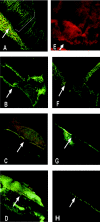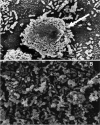Role of sialic acid and complex carbohydrate biosynthesis in biofilm formation by nontypeable Haemophilus influenzae in the chinchilla middle ear
- PMID: 15908345
- PMCID: PMC1111813
- DOI: 10.1128/IAI.73.6.3210-3218.2005
Role of sialic acid and complex carbohydrate biosynthesis in biofilm formation by nontypeable Haemophilus influenzae in the chinchilla middle ear
Abstract
Nontypeable Haemophilus influenzae (NTHI) is an important pathogen in respiratory tract infections, including otitis media (OM). NTHI forms biofilms in vitro as well as in the chinchilla middle ear, suggesting that biofilm formation in vivo might play an important role in the pathogenesis and chronicity of OM. We've previously shown that SiaA, SiaB, and WecA are involved in biofilm production by NTHI in vitro. To investigate whether these gene products were also involved in biofilm production in vivo, NTHI strain 2019 and five isogenic mutants with deletions in genes involved in carbohydrate biosynthesis were inoculated into the middle ears of chinchillas. The wild-type strain formed a large, well-organized, and viable biofilm; however, the wecA, lsgB, siaA, pgm, and siaB mutants were either unable to form biofilms or formed biofilms of markedly reduced mass, organization, and viability. Despite their compromised ability to form a biofilm in vivo, wecA, lsgB, and siaA mutants survived in the chinchilla, inducing culture-positive middle ear effusions, whereas pgm and siaB mutants were extremely sensitive to the bactericidal activity of chinchilla serum and thus did not survive. Lectin analysis indicated that sialic acid was an important component of the NTHI 2019 biofilm produced in vivo. Our data suggested that genes involved in carbohydrate biosynthesis and assembly play an important role in the ability of NTHI to form a biofilm in vivo. Collectively, we found that when modeled in a mammalian host, whereas biofilm formation was not essential for survivability of NTHI in vivo, lipooligosaccharide sialylation was indispensable.
Figures






Similar articles
-
Nontypeable Haemophilus influenzae strain 2019 produces a biofilm containing N-acetylneuraminic acid that may mimic sialylated O-linked glycans.Infect Immun. 2004 Jul;72(7):4249-60. doi: 10.1128/IAI.72.7.4249-4260.2004. Infect Immun. 2004. PMID: 15213170 Free PMC article.
-
In Silico Modeling of Biofilm Formation by Nontypeable Haemophilus influenzae In Vivo.mSphere. 2019 Jul 31;4(4):e00254-19. doi: 10.1128/mSphere.00254-19. mSphere. 2019. PMID: 31366707 Free PMC article.
-
Phosphorylcholine decreases early inflammation and promotes the establishment of stable biofilm communities of nontypeable Haemophilus influenzae strain 86-028NP in a chinchilla model of otitis media.Infect Immun. 2007 Feb;75(2):958-65. doi: 10.1128/IAI.01691-06. Epub 2006 Nov 27. Infect Immun. 2007. PMID: 17130253 Free PMC article.
-
Haemophilus influenzae biofilms: hypothesis or fact?Trends Microbiol. 2008 Mar;16(3):95-100. doi: 10.1016/j.tim.2007.12.005. Epub 2008 Feb 14. Trends Microbiol. 2008. PMID: 18280163 Review.
-
Novel concepts in nontypeable Haemophilus influenzae biofilm formation.FEMS Microbiol Lett. 2013 Sep;346(2):81-9. doi: 10.1111/1574-6968.12203. Epub 2013 Jul 15. FEMS Microbiol Lett. 2013. PMID: 23808954 Review.
Cited by
-
Host-like carbohydrates promote bloodstream survival of Vibrio vulnificus in vivo.Infect Immun. 2015 Aug;83(8):3126-36. doi: 10.1128/IAI.00345-15. Epub 2015 May 26. Infect Immun. 2015. PMID: 26015477 Free PMC article.
-
Sialylation of lipooligosaccharides is dispensable for the virulence of Haemophilus ducreyi in humans.Infect Immun. 2012 Feb;80(2):679-87. doi: 10.1128/IAI.05826-11. Epub 2011 Dec 5. Infect Immun. 2012. PMID: 22144477 Free PMC article.
-
Extracellular DNA within a nontypeable Haemophilus influenzae-induced biofilm binds human beta defensin-3 and reduces its antimicrobial activity.J Innate Immun. 2013;5(1):24-38. doi: 10.1159/000339961. Epub 2012 Aug 22. J Innate Immun. 2013. PMID: 22922323 Free PMC article.
-
Structural and functional characterization of a modified legionaminic acid involved in glycosylation of a bacterial lipopolysaccharide.J Biol Chem. 2018 Dec 7;293(49):19113-19126. doi: 10.1074/jbc.RA118.004966. Epub 2018 Oct 12. J Biol Chem. 2018. PMID: 30315110 Free PMC article.
-
Bacterial catabolism of nonulosonic (sialic) acid and fitness in the gut.Gut Microbes. 2010 Jan;1(1):45-50. doi: 10.4161/gmic.1.1.10386. Gut Microbes. 2010. PMID: 21327116 Free PMC article.
References
-
- Andreoni, J., H. Kayhty, and P. Densen. 1993. Vaccination and the role of capsular polysaccharide antibody in prevention of recurrent meningococcal disease in late complement component-deficient individuals. J. Infect. Dis. 168:227-231. - PubMed
-
- Bakaletz, L. O., B. J. Kennedy, L. A. Novotny, G. Duquesne, J. Cohen, and Y. Lobet. 1999. Protection against development of otitis media induced by nontypeable Haemophilus influenzae by both active and passive immunization in a chinchilla model of virus-bacterium superinfection. Infect. Immun. 67:2746-2762. - PMC - PubMed
-
- Brinkman-Van der Linden, E. C., J. L. Sonnenburg, and A. Varki. 2002. Effects of sialic acid substitutions on recognition by Sambucus nigra agglutinin and Maackia amurensis hemagglutinin. Anal. Biochem. 303:98-104. - PubMed
Publication types
MeSH terms
Substances
Grants and funding
LinkOut - more resources
Full Text Sources
Other Literature Sources

